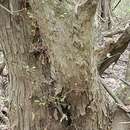Comments
provided by eFloras
Planera aquatica is endemic to southeastern United States.
- license
- cc-by-nc-sa-3.0
- copyright
- Missouri Botanical Garden, 4344 Shaw Boulevard, St. Louis, MO, 63110 USA
Description
provided by eFloras
Leaves: petiole 3-6 mm. Leaf blade 3-8 × (2-)2.5(-4) cm. Flowers: if bisexual, ovary stalked, 1-locular, ovoid, tubercular; styles 2, reflexed. Fruits stalked, compressed, ca. 8 mm, leathery, hirtellous, covered with irregular warty excrescences. Seeds ovoid.
- license
- cc-by-nc-sa-3.0
- copyright
- Missouri Botanical Garden, 4344 Shaw Boulevard, St. Louis, MO, 63110 USA
Distribution
provided by eFloras
Ala., Ark., Fla., Ga., Ill., Ky., La., Miss., Mo., N.C., Okla., S.C., Tenn., Tex.
- license
- cc-by-nc-sa-3.0
- copyright
- Missouri Botanical Garden, 4344 Shaw Boulevard, St. Louis, MO, 63110 USA
Flowering/Fruiting
provided by eFloras
Flowering spring (Apr-May).
- license
- cc-by-nc-sa-3.0
- copyright
- Missouri Botanical Garden, 4344 Shaw Boulevard, St. Louis, MO, 63110 USA
Habitat
provided by eFloras
Swamps, streams, lakes, alluvial flood plains, often forming large stands; 0-200m.
- license
- cc-by-nc-sa-3.0
- copyright
- Missouri Botanical Garden, 4344 Shaw Boulevard, St. Louis, MO, 63110 USA
Planera aquatica
provided by wikipedia EN
Planera aquatica,[2] the planertree[3] or water elm, is a species of flowering plant. Found in the southeastern United States, it is a small deciduous tree 10–15 m tall, closely related to the elms but with a softly, prickly nut 10–15 mm diameter, instead of a winged seed. It grows, as the name suggests, on wet sites. Despite its common English name, this species is not a true elm, although it is a close relative of the elms (species of the genus Ulmus). It is also subject to Dutch elm disease, a disease which affects only members of the Ulmaceae. It is native to most of the southeast United States. It is hardy down to Zone 7.[4]
Description
Leaf underside displaying pubescence
Fruit with and without shell
-
Leaves: alternate, 3–7 cm long, with irregularly serrated to double serrated margins. Leaf base wedge-shaped or rounded. Leaf base often equal and symmetrical, but can be asymmetrical.[5] Thin pubescent hair is often present on underside of leaf.
- Bark: gray-brown, thin, some flaky loose scales. Exfoliates to reveal red-brown area under bark.[5][6]
- Fruit: a drupe. Has a green shell that turns brown with age. Matures April - May.[5]
Distinguishing characteristics
While often confused with true elms, it can be easily distinguished by noticing the fruit are drupes and not samaras. When fruit are not in season, the flaky bark is unique to water elm and not characteristic of true elms.[5]
May also be confused with Celtis (hackberries), but hackberry leaves have pronounced lower lateral veins not found on water elm.[5]
Ecology
Typically found on alluvial floodplains subjected to seasonal or temporary flooding.[5] Often found in swamps, streams, lakes, or in riparian areas. Has some wildlife value, food for bees and some bird species. Prefers sandy or gravelly, moist soils.[6]
Classified as an obligate wetland plant (OBL).[3]
References
-
^ IUCN SSC Global Tree Specialist Group.; Botanic Gardens Conservation International; et al. (BGCI) (2020). "Planera aquatica". IUCN Red List of Threatened Species. 2020: e.T152858603A152905699. doi:10.2305/IUCN.UK.2020-1.RLTS.T152858603A152905699.en. Retrieved 19 November 2021.
-
^ a b "Search results for Planera". The Plant List. Retrieved 1 March 2016.
-
^ a b USDA, NRCS (n.d.). "Planera aquatica". The PLANTS Database (plants.usda.gov). Greensboro, North Carolina: National Plant Data Team. Retrieved 7 October 2015.
-
^ "Water Elm Ulmaceae Planera aquatica J.F. Gmel". Virginia Tech Department of Forestry and Environmental Conservation. Retrieved December 15, 2014.
-
^ a b c d e f Kirkman, L. Katherine. (2007). Native trees of the Southeast. Brown, Claud L., 1925-, Leopold, Donald Joseph, 1956-. Portland, Or.: Timber Press. ISBN 978-0-88192-828-0. OCLC 69792028.
-
^ a b "Planera aquatica (Water Elm) | North Carolina Extension Gardener Plant Toolbox". plants.ces.ncsu.edu. Retrieved 2020-11-02.

- license
- cc-by-sa-3.0
- copyright
- Wikipedia authors and editors
Planera aquatica: Brief Summary
provided by wikipedia EN
Planera aquatica, the planertree or water elm, is a species of flowering plant. Found in the southeastern United States, it is a small deciduous tree 10–15 m tall, closely related to the elms but with a softly, prickly nut 10–15 mm diameter, instead of a winged seed. It grows, as the name suggests, on wet sites. Despite its common English name, this species is not a true elm, although it is a close relative of the elms (species of the genus Ulmus). It is also subject to Dutch elm disease, a disease which affects only members of the Ulmaceae. It is native to most of the southeast United States. It is hardy down to Zone 7.
- license
- cc-by-sa-3.0
- copyright
- Wikipedia authors and editors

